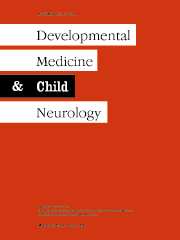Crossref Citations
This article has been cited by the following publications. This list is generated based on data provided by
Crossref.
Ramakers, Ger J. A.
and
Ponsioen, Albert J. G. B.
2007.
Neuropsychologische kenmerken van kinderen en adolescenten met een (lichte) verstandelijke beperking.
Kind en adolescent,
Vol. 28,
Issue. 3,
p.
78.
van der Molen, Mariët J.
van Luit, Hans E. H.
Jongmans, Marian J.
and
van der Molen, Maurits W.
2007.
Het werkgeheugen van jongeren met een lichte verstandelijke beperking.
Kind en adolescent,
Vol. 28,
Issue. 3,
p.
88.
Pagliano, Emanuela
Fedrizzi, Ermellina
Erbetta, Alessandra
Bulgheroni, Sara
Solari, Alessandra
Bono, Renata
Fazzi, Elisa
Andreucci, Elena
and
Riva, Daria
2007.
Cognitive Profiles and Visuoperceptual Abilities in Preterm and Term Spastic Diplegic Children With Periventricular Leukomalacia.
Journal of Child Neurology,
Vol. 22,
Issue. 3,
p.
282.
García, Claudia Lorena
2007.
Cognitive Modularity, Biological Modularity, and Evolvability.
Biological Theory,
Vol. 2,
Issue. 1,
p.
62.
Morice, Elise
Andreae, Laura C.
Cooke, Sam F.
Vanes, Lesley
Fisher, Elizabeth M.C.
Tybulewicz, Victor L.J.
and
Bliss, Timothy V.P.
2008.
Preservation of long-term memory and synaptic plasticity despite short-term impairments in the Tc1 mouse model of Down syndrome.
Learning & Memory,
Vol. 15,
Issue. 7,
p.
492.
Nass, Ruth
and
Ross, Gail
2008.
Neurology in Clinical Practice.
p.
1739.
Stinton, Chris
Farran, Emily K.
and
Courbois, Yannick
2008.
Mental Rotation in Williams Syndrome: An Impaired Ability.
Developmental Neuropsychology,
Vol. 33,
Issue. 5,
p.
565.
Farran, Emily K.
2008.
Strategies and biases in location memory in Williams syndrome.
Research in Developmental Disabilities,
Vol. 29,
Issue. 5,
p.
385.
Nardini, Marko
Atkinson, Janette
Braddick, Oliver
and
Burgess, Neil
2008.
Developmental trajectories for spatial frames of reference in Williams syndrome.
Developmental Science,
Vol. 11,
Issue. 4,
p.
583.
Farran, Emily K.
and
Cole, Victoria L.
2008.
Perceptual grouping and distance estimates in typical and atypical development: Comparing performance across perception, drawing and construction tasks.
Brain and Cognition,
Vol. 68,
Issue. 2,
p.
157.
O’Hearn, Kirsten
Courtney, Susan
Street, Whitney
and
Landau, Barbara
2009.
Working memory impairment in people with Williams syndrome: Effects of delay, task and stimuli.
Brain and Cognition,
Vol. 69,
Issue. 3,
p.
495.
Frenkel, S.
and
Bourdin, B.
2009.
Verbal, visual, and spatio‐sequential short‐term memory: assessment of the storage capacities of children and teenagers with Down's syndrome.
Journal of Intellectual Disability Research,
Vol. 53,
Issue. 2,
p.
152.
Cornish, Kim M.
Kogan, Cary S.
Li, Lexin
Turk, Jeremy
Jacquemont, Sebastien
and
Hagerman, Randi J.
2009.
Lifespan changes in working memory in fragile X premutation males.
Brain and Cognition,
Vol. 69,
Issue. 3,
p.
551.
Lanfranchi, S.
Carretti, B.
Spanò, G.
and
Cornoldi, C.
2009.
A specific deficit in visuospatial simultaneous working memory in Down syndrome.
Journal of Intellectual Disability Research,
Vol. 53,
Issue. 5,
p.
474.
Pereira, Patricia Lopes
Magnol, Laetitia
Sahún, Ignasi
Brault, Véronique
Duchon, Arnaud
Prandini, Paola
Gruart, Agnès
Bizot, Jean-Charles
Chadefaux-Vekemans, Bernadette
Deutsch, Samuel
Trovero, Fabrice
Delgado-García, José María
Antonarakis, Stylianos E.
Dierssen, Mara
and
Herault, Yann
2009.
A new mouse model for the trisomy of the Abcg1–U2af1 region reveals the complexity of the combinatorial genetic code of down syndrome.
Human Molecular Genetics,
Vol. 18,
Issue. 24,
p.
4756.
Glue, Paul
and
Patterson, Tess
2009.
Can Drug Treatments Enhance Learning in Subjects with Intellectual Disability?.
Australian & New Zealand Journal of Psychiatry,
Vol. 43,
Issue. 10,
p.
899.
Dierssen, Mara
Herault, Yann
and
Estivill, Xavier
2009.
Aneuploidy: From a Physiological Mechanism of Variance to Down Syndrome.
Physiological Reviews,
Vol. 89,
Issue. 3,
p.
887.
Mandolesi, L.
Addona, F.
Foti, F.
Menghini, D.
Petrosini, L.
and
Vicari, S.
2009.
Spatial competences in Williams syndrome: a radial arm maze study.
International Journal of Developmental Neuroscience,
Vol. 27,
Issue. 3,
p.
205.
Lott, Ira T
and
Dierssen, Mara
2010.
Cognitive deficits and associated neurological complications in individuals with Down's syndrome.
The Lancet Neurology,
Vol. 9,
Issue. 6,
p.
623.
Edgin, Jamie O.
Pennington, Bruce F.
and
Mervis, Carolyn B.
2010.
Neuropsychological components of intellectual disability: the contributions of immediate, working, and associative memory.
Journal of Intellectual Disability Research,
Vol. 54,
Issue. 5,
p.
406.




